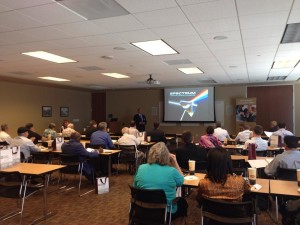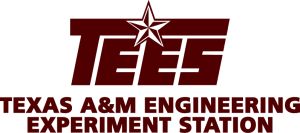BY LAURA LOREK
Founder of Silicon Hills News
 Roy Truitt, founder of Austin-based startup ScanSee, wants to tap into Texas A&M’s rich engineering resources.
Roy Truitt, founder of Austin-based startup ScanSee, wants to tap into Texas A&M’s rich engineering resources.
Truitt, a serial entrepreneur who founded Truco Enterprises, which makes the On the Border brand of chips and salsas, created ScanSee four years ago. It makes an app, HubCiti, which can link all of a city’s businesses, departments, services and shoppers together.
On Tuesday, Truitt attended the Texas A&M Matchmaker Workshop in Austin at the Frost Bank Tower, it’s part of a series of programs called Spectrum focused on entrepreneurial mentorship, education and collaboration.
Truitt is interested in working on security software features for HubCiti in collaboration with Texas A&M. He credits the Texas State Small Business Development Center, which puts on the Spectrum series of events, for bringing a wealth of information to startup entrepreneurs.
“I had no idea this even existed and this is my business,” Truitt said. “I’ve started 17 companies so I should know this existed.”
 Most people don’t know about all of the resources available to entrepreneurs at Texas A&M, said Dick Johnson, assistant director of technology at Texas State Small Business Development Center. Since Spectrum launched last July, the center has hosted eight events attended by more than 500 people on a variety of subjects from perfecting a pitch to understanding a term sheet.
Most people don’t know about all of the resources available to entrepreneurs at Texas A&M, said Dick Johnson, assistant director of technology at Texas State Small Business Development Center. Since Spectrum launched last July, the center has hosted eight events attended by more than 500 people on a variety of subjects from perfecting a pitch to understanding a term sheet.
“It’s all about sharing knowledge,” Johnson said. “It’s designed to increase awareness of some of the resources available for free, in most cases, to entrepreneurs.”
On Tuesday, five officials from Texas A&M gave brief overviews of their programs to assist companies with technology development and commercialization. The presentations involved a whole lot of acronyms representing the organizations including TEES, TCAT, TEEX, TTI, TTC and TAP. After the presentations, they met one on one with entrepreneurs to provide further assistance.
 The Texas A&M Engineering Experiment Station, called TEES, provides research, education, training and technology to companies and industries, said Dale Cope, director of industry assistance.
The Texas A&M Engineering Experiment Station, called TEES, provides research, education, training and technology to companies and industries, said Dale Cope, director of industry assistance.
Texas A&M has 13,600 engineering students or 23 percent of the student population with more than 13 departments, he said. It’s one of the largest engineering schools in the country and its students and faculty work on tackling real-life engineering problems for industries.
TEES’ current research focuses on just about anything that has to do with engineering from energy to health care, national security, infomatics, infrastructure and transportation, Cope said. Its emerging research areas include robotics, sensors, imaging, advanced manufacturing and advanced materials for energy applications, he said.

E-Loo, photo courtesy of SWSLoo.com
George and Jeri Willa, husband and wife owners of
Elgin-based SWSLoo, the American maker and distributor of Enviro Loo, a green toilet, attended the event to get some engineering help on their product. The Eloo, as it is known, is low maintenance and doesn’t require water, electricity or chemicals.
“We’ve been working on this project for six to eight years,” George Willa said. “We licensed the toilet from South Africa but we need to get more engineering in the product.”
They are also looking for more consistent market penetration through marketing efforts, Jeri Willa said. They are already selling products in 30 states and several countries including Canada, Mexico and Haiti.
“We’re still a small company and we’re still trying to improve our product,” Jeri Willa said. “That’s why we came here for engineering assistant.”
They were thrilled to have an opportunity to connect with Texas A&M’s engineering expertise, she said.
Nick Chremos, senior licensing manager for Texas A&M’s technology commercialization department, said it wants to partner with startups and industry to license technology developed there and get it into the marketplace.
The university has a whole patent portfolio of technologies it’s interested in working with companies on to build a product or service around, he said.
“There isn’t a single area of engineering where A&M doesn’t have expertise,” he said.
Some of the highway safety technology patents, created by Dean Alberson, assistant agency director of the Texas A&M Transportation Institute, have generated the most revenue for the university, Chremos said. The university shares 37.5 percent of all royalties with the inventor, he said.
One of the most active industry partners at the university is the Texas A&M Transportation Institute with 700 employees. It is the largest transportation research group in the U.S. and it has worked in all 50 states and more than 20 countries.

Photo of the driverless freight shuttle system, courtesy of Texas A&M
Last year, the institute worked on 677 projects and did $53.6 million in contract research. The work at the institute makes highways safer, Alberson said. It has helped to create breakaway signs, crash cushions and barriers that save lives, he said.
The institute is currently working on a freight shuttle system, a private venture, that would take trucks off the highway and transport freight on an elevated system above them using driverless vehicles.
One of the emerging inventions the university is particularly excited about is in using polymer materials to convert heat into electricity, Chremos said.
“We’re looking to find licensees,” he said.
Caleb Holt, product development center manager for Texas A&M Engineering Extension Service, known as TEEX, works directly with companies to help them with product development, training and other services. It works in the areas of fire and rescue, homeland security, law enforcement and infrastructure and safety.
But it also tests systems, products and technology. Its product development portfolio includes responder tracking systems, weapon systems, environmentally friendly fire chemicals and more.
TEEX provides third party, unbiased testing for disruptive technologies, Holt said.
“We help to create standards for technology that don’t have standards yet,” he said.
“The Underwriters Laboratories testing takes place in a lab, but TEEX tests products in the most realistic scenarios possible,” Holt said.
It will take a Toughbooks rugged laptop computer and put it on black asphalt in the 100 degree Texas weather to make sure it really does meet military grade specs, he said.
![]() The U.S. government invests more than $2 billion every year in promising new startups with creative innovations.
The U.S. government invests more than $2 billion every year in promising new startups with creative innovations.